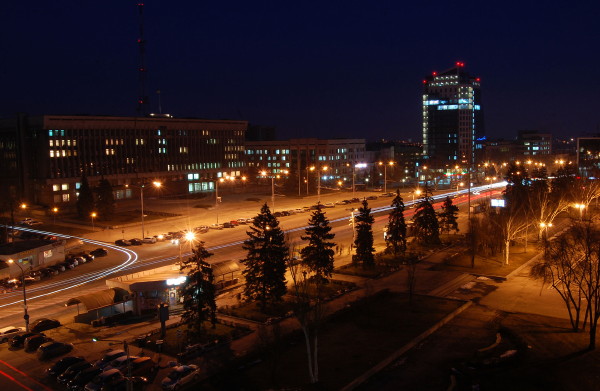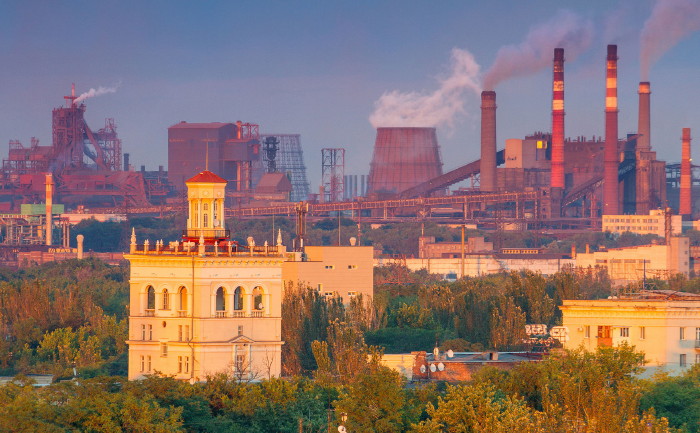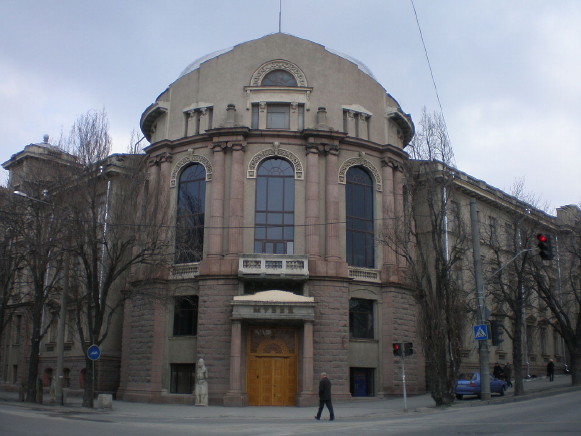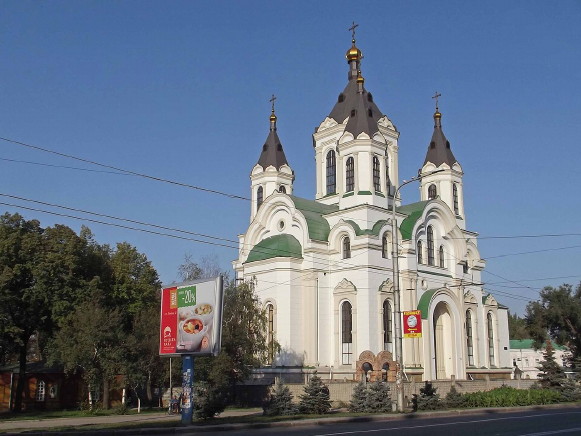Zaporizhia
Zaporizhia [Запоріжжя; Zaporižžja]. Map: VI-16. A city (2016 pop 754,619) on the Dnipro River and the administrative center of Zaporizhia oblast and raion. It is a river port, a railway junction, and the second-largest industrial city in the Dnipro Industrial Region. Until 1921 the city was called Oleksandrivske.
The city grew up around Oleksandrivske fortress, which was built in 1770, and which formed a link in the defensive front (the Dnipro Line) against the Crimean Khanate. The vicinity, situated at the southern end of the Dnipro Rapids, had long been a stopping point for travelers and traders on the Dnipro River route. The Zaporizhia Cossack stronghold of Khortytsia Island had been located on the island opposite the new settlement. After Russia’s annexation of the Crimea in 1783, the fortress lost its military importance. Many of its demobilized soldiers settled in or around Oleksandrivske, which became a small administrative-commercial town. From 1806 it was a county center in Katerynoslav gubernia. Its agriculture-based economy grew slowly: the town’s population increased from 1,700 in 1824 to only 3,700 in 1861. Oleksandrivske’s rapid growth did not begin until the 1870s. After being linked by railroad transportation to Moscow in 1873 and Sevastopol in 1875, the town became a major transfer point, at which commodities (notably grain) were transferred from rail to river barges for shipment downriver to the seaports. At the same time its own industry, particularly agricultural machine building, developed. By 1910 there were three large machine-building plants in Oleksandrivske. The completion of a railway line from the Donbas to Kryvyi Rih in 1902 stimulated the growth of metallurgy. The city’s population grew from approximately 7,000 in 1885 to 19,000 in 1897 and 38,000 in 1910. The city in 1897 was 43 percent Ukrainian, 28 percent Jewish, and 25 percent Russian.
During the revolutionary period of Ukraine’s struggle for independence (1917–20) the city was heavily damaged before Soviet rule was entrenched in 1920. It was rapidly rebuilt, and expanded northward and to the western bank of the Dnipro River. The construction of the Dnipro Hydroelectric Station nearby provided the energy for the extensive growth of the metallurgical industry in the 1930s. Using iron ore from the Kryvyi Rih Iron-ore Basin, manganese ore from the Nikopol Manganese Basin, and coal from the Donbas, Zaporizhia soon became the second-largest (after Dnipropetrovsk) metallurgical center in the Dnipro River region. Some of its major enterprises were expanded or founded during the interwar period, including the Komunar machine plant (the Zaporizhia Komunar Automobile Plant), the Zaporizhstal metallurgical plant, the Instrumental Steels Plant (the Zaporizhia Dniprospetsstal Electrometallurgical Plant), and the Dnipro Aluminum Plant (est 1930). The city’s population rose abruptly, from 56,000 in 1926 to 290,000 in 1939. During the Second World War much of the city, including the hydroelectric station, was destroyed. It was occupied by the Germans in October 1941 and recaptured by the Soviet Army in October 1943. Its industry and power station were rebuilt and expanded during postwar reconstruction.
Today Zaporizhia is the sixth-largest city in Ukraine. The old town is spread out along a low-lying terrace on the left bank of the Dnipro River directly across from Khortytsia Island. The new town is situated several kilometers to the north. Its main street runs south for more than 10 km from the hydroelectric dam to the railway station. The area between the old and new towns has slowly been built up with residential districts. The city encompasses Khortytsia Island and the right bank. There are rest homes and sanatoriums on Khortytsia Island. Public urban transit consists of streetcars, buses, and trolleybuses.
Metallurgy and machine building are the main industries of Zaporizhia. They include some giant plants, such as the Zaporizhstal and Dniprospetsstal steel mills, the Dnipro Aluminum Plant, the titanium-magnesium plant, the Zaporizhia Transformer Plant, the Zaporizhia Automobile Plant, an engine plant, and an electric instruments factory. The chemical industry, which sprang up after the Second World War, includes the Kremniipolimer plant, which manufactures synthetic leather, petroleum refineries, and antibiotic and yeast factories. The building-materials industry produces reinforced-concrete structures, bricks, and prefabricated wall sections. The food industry includes confectionery factories, two breweries, and meatpacking plants. The light industry produces mainly clothing and footwear.
The city is an educational and research center. It has several institutions of higher education, including the Zaporizhia National University as well as a technical university, a medical university, and an engineering academy, 16 gymnasiums and 12 other specialized secondary schools. There are many scientific research institutes specializing in areas such as transformer design, titanium, special alloys, and ferrous metals. The city’s cultural facilities include the Zaporizhia Regional Studies Museum, the Zaporizhia Art Museum, a philharmonic society, and four theaters (the Zaporizhia Academic Ukrainian Music and Drama Theater, the Zaporizhia Academic Youth Theater, the VIE Municipal theater-laboratory, and a puppet theater). The chief architectural monuments are the remains of the Zaporozhian Sich fortifications (1735–9) on Khortytsia Island, the zemstvo building (1912), and the Dnipro Hydroelectric Station dam.
[This article was updated in 2016.]




.jpg)

